Facial Expressions of Urban Forest Visitors Jointly Exposed to Air Pollution and Regional Climate
Abstract
1. Introduction
2. Materials and Methods
2.1. Study Area
2.2. Data Collection
2.3. Statistical Analysis
3. Results
3.1. Socioeconomic Dimensions and Air Pollution among Cities at Varied Urbanization Levels
3.2. Spatial Distributions of Meteorological Factors
3.3. Correlations between Pairs of Variables in Air Quality, Climate, and Socioeconomics
3.4. Facial Expression Scores in Urban Forest Visitors of Cities at Varied Urbanization Levels
3.5. Regressions of Facial Expression Scores against Air Quality, Regional Climate, and Socioeconomics
4. Discussion
4.1. Differences between Socioeconomic Indicators and Air Pollutant
4.2. Spatiotemporal Distribution of Air Pollutants and Meteorological Factors
4.3. Forest Visitors’ Emotional Perceptions under Different Urbanization Levels
4.4. Responses of Forest Visitors’ Emotional Perceptions to Combined Socioeconomic Indicators, Air Pollutants, and Meteorological Factors
4.5. Limitations of the Current Study
5. Conclusions
Supplementary Materials
Author Contributions
Funding
Data Availability Statement
Acknowledgments
Conflicts of Interest
References
- Geng, G.N.; Zheng, Y.X.; Zhang, Q.; Xue, T.; Zhao, H.Y.; Tong, D.; Zheng, B.; Li, M.; Liu, F.; Hong, C.P.; et al. Drivers of PM2.5 air pollution deaths in China 2002–2017. Nat. Geosci. 2021, 14, 645–650. [Google Scholar] [CrossRef]
- Wang, S.J.; Zhou, C.S.; Wang, Z.B.; Feng, K.S.; Hubacek, K. The characteristics and drivers of fine particulate matter (PM2.5) distribution in China. J. Clean Prod. 2017, 142, 1800–1809. [Google Scholar] [CrossRef]
- West, J.J.; Cohen, A.; Dentener, F.; Brunekreef, B.; Zhu, T.; Armstrong, B.; Bell, M.L.; Brauer, M.; Carmichael, G.; Costa, D.L.; et al. What We Breathe Impacts Our Health: Improving Understanding of the Link between Air Pollution and Health. Environ. Sci. Technol. 2016, 50, 4895–4904. [Google Scholar] [CrossRef]
- Zheng, S.Q.; Wang, J.H.; Sun, C.; Zhang, X.N.; Kahn, M.E. Air pollution lowers Chinese urbanites’ expressed happiness on social media. Nat. Hum. Behav. 2019, 3, 237–243. [Google Scholar] [CrossRef] [PubMed]
- Ji, H.M.; Wang, J.; Meng, B.; Cao, Z.; Yang, T.; Zhi, G.Q.; Chen, S.Y.; Wang, S.H.; Zhang, J.Q. Research on adaption to air pollution in Chinese cities: Evidence from social media-based health sensing. Environ. Res. 2022, 210, 11. [Google Scholar] [CrossRef]
- Chen, F.; Zhang, X.; Chen, Z. Air pollution and mental health: Evidence from China Health and Nutrition Survey. J. Asian Econ. 2023, 86, 101611. [Google Scholar] [CrossRef]
- Bi, X.H.; Dai, Q.L.; Wu, J.H.; Zhang, Q.; Zhang, W.H.; Luo, R.X.; Cheng, Y.; Zhang, J.Y.; Wang, L.; Yu, Z.J.; et al. Characteristics of the main primary source profiles of particulate matter across China from 1987 to 2017. Atmos. Chem. Phys. 2019, 19, 3223–3243. [Google Scholar] [CrossRef]
- Fan, H.; Zhao, C.F.; Yang, Y.K. A comprehensive analysis of the spatio-temporal variation of urban air pollution in China during 2014–2018. Atmos. Environ. 2020, 220, 12. [Google Scholar] [CrossRef]
- Sarrat, C.; Lemonsu, A.; Masson, V.; Guedalia, D. Impact of urban heat island on regional atmospheric pollution. Atmos. Environ. 2006, 40, 1743–1758. [Google Scholar] [CrossRef]
- Tiwari, S.; Srivastava, A.K.; Bisht, D.S.; Parmita, P.; Srivastava, M.K.; Attri, S.D. Diurnal and seasonal variations of black carbon and PM2.5 over New Delhi, India: Influence of meteorology. Atmos. Res. 2013, 125, 50–62. [Google Scholar] [CrossRef]
- Cogliani, E. Air pollution forecast in cities by an air pollution index highly correlated with meteorological variables. Atmos. Environ. 2001, 35, 2871–2877. [Google Scholar] [CrossRef]
- Li, Y.; Guan, D.; Yu, Y.; Westland, S.; Wang, D.; Meng, J.; Wang, X.; He, K.; Tao, S. A psychological measurement on subjective well-being and air pollution. Nature Comm. 2019, 10, 5473. [Google Scholar] [CrossRef]
- Escobedo, F.J.; Wagner, J.E.; Nowak, D.J.; De la Maza, C.L.; Rodriguez, M.; Crane, D.E. Analyzing the cost effectiveness of Santiago, Chile’s policy of using urban forests to improve air quality. J. Environ. Manag. 2008, 86, 148–157. [Google Scholar] [CrossRef] [PubMed]
- Xu, C.; Dong, L.; Yu, C.; Zhang, Y.; Cheng, B. Can forest city construction affect urban air quality? The evidence from the Beijing-Tianjin-Hebei urban agglomeration of China. J. Clean Prod. 2020, 264, 121607. [Google Scholar] [CrossRef]
- Yuan, L.; Shin, K.; Managi, S. Subjective Well-being and Environmental Quality: The Impact of Air Pollution and Green Coverage in China. Ecol. Econ. 2018, 153, 124–138. [Google Scholar] [CrossRef]
- Wei, H.X.; Hauer, R.J.; Guo, S.L. Daytime dynamic of spontaneous expressions of pedestrians in an urban forest park. Urban For. Urban Green. 2021, 65, 10. [Google Scholar] [CrossRef]
- Liu, P.; Liu, M.N.; Xia, T.T.; Wang, Y.T.; Wei, H.X. Can Urban Forest Settings Evoke Positive Emotion? Evidence on Facial Expressions and Detection of Driving Factors. Sustainability 2021, 13, 8687. [Google Scholar] [CrossRef]
- Wei, H.X.; Hauer, R.J.; Chen, X.; He, X.Y. Facial Expressions of Visitors in Forests along the Urbanization Gradient: What Can We Learn from Selfies on Social Networking Services? Forests 2019, 10, 1049. [Google Scholar] [CrossRef]
- Wei, H.X.; Ma, B.Q.; Hauer, R.J.; Liu, C.Y.; Chen, X.; He, X.Y. Relationship between environmental factors and facial expressions of visitors during the urban forest experience. Urban For. Urban Green. 2020, 53, 10. [Google Scholar] [CrossRef]
- Mao, B.; Liang, F.; Li, Z.Z.; Zheng, W.Q. Microclimates Potentially Shape Spatial Distribution of Facial Expressions for Urban Forest Visitors: A Regional Study of 30 Parks in North China. Sustainability 2022, 14, 1648. [Google Scholar] [CrossRef]
- Li, Y.J.; Sun, Y.X.; Zhao, Y.; Wang, Y.; Cheng, S.P. Mapping seasonal sentiments of people visiting blue spaces in urban wetlands: A pilot study on inland cities of China. Front. Ecol. Evol. 2022, 10, 18. [Google Scholar] [CrossRef]
- Wei, H.X.; Hauer, R.J.; Sun, Y.X.; Meng, L.Q.; Guo, P. Emotional perceptions of people exposed to green and blue spaces in forest parks of cities at rapid urbanization regions of East China. Urban For. Urban Green. 2022, 78, 16. [Google Scholar] [CrossRef]
- Li, H.Y.; Wang, X.G.; Wei, H.X.; Xia, T.T.; Liu, M.N.; Ai, S.S. Geographical Distribution and Driving Meteorological Forces of Facial Expressions of Visitors in Urban Wetland Parks in Eastern China. Front. Earth Sci. 2022, 10, 13. [Google Scholar] [CrossRef]
- He, Q.; Wang, Y.; Qiu, Q.; Su, Y.; Wang, Y.; Wei, H.X.; Li, J.Y. Joint effects of air PM2.5 and socioeconomic dimensions on posted emotions of urban green space visitors in cities experiencing population urbanization: A pilot study on 50 cities of East China. Sci. Total Environ. 2023, 861, 160607. [Google Scholar] [CrossRef]
- He, J.J.; Gong, S.L.; Yu, Y.; Yu, L.J.; Wu, L.; Mao, H.J.; Song, C.B.; Zhao, S.P.; Liu, H.L.; Li, X.Y.; et al. Air pollution characteristics and their relation to meteorological conditions during 2014-2015 in major Chinese cities. Environ. Pollut. 2017, 223, 484–496. [Google Scholar] [CrossRef]
- Wang, X.Y.; Dickinson, R.E.; Su, L.Y.; Zhou, C.L.E.; Wang, K.C. PM2.5 Pollution In China And How It Has Been Exacerbated By Terrain And Meteorological Conditions. Bull. Amer. Meteorol. Soc. 2018, 99, 105–120. [Google Scholar] [CrossRef]
- Chen, Z.Y.; Xie, X.M.; Cai, J.; Chen, D.L.; Gao, B.B.; He, B.; Cheng, N.L.; Xu, B. Understanding meteorological influences on PM2.5 concentrations across China: A temporal and spatial perspective. Atmos. Chem. Phys. 2018, 18, 5343–5358. [Google Scholar] [CrossRef]
- Pendergrass, D.C.; Shen, L.; Jacob, D.J.; Mickley, L.J. Predicting the Impact of Climate Change on Severe Wintertime Particulate Pollution Events in Beijing Using Extreme Value Theory. Geophys. Res. Lett. 2019, 46, 1824–1830. [Google Scholar] [CrossRef]
- Zhao, S.P.; Yin, D.Y.; Yu, Y.; Kang, S.C.; Qin, D.H.; Dong, L.X. PM2.5 and O-3 pollution during 2015-2019 over 367 Chinese cities: Spatiotemporal variations, meteorological and topographical impacts. Environ. Pollut. 2020, 264, 10. [Google Scholar] [CrossRef]
- Song, C.B.; Wu, L.; Xie, Y.C.; He, J.J.; Chen, X.; Wang, T.; Lin, Y.C.; Jin, T.S.; Wang, A.X.; Liu, Y.; et al. Air pollution in China: Status and spatiotemporal variations. Environ. Pollut. 2017, 227, 334–347. [Google Scholar] [CrossRef]
- Wang, Y.G.; Ying, Q.; Hu, J.L.; Zhang, H.L. Spatial and temporal variations of six criteria air pollutants in 31 provincial capital cities in China during 2013–2014. Environ. Int. 2014, 73, 413–422. [Google Scholar] [CrossRef] [PubMed]
- Liu, H.M.; Fang, C.L.; Zhang, X.L.; Wang, Z.Y.; Bao, C.; Li, F.Z. The effect of natural and anthropogenic factors on haze pollution in Chinese cities: A spatial econometrics approach. J. Clean Prod. 2017, 165, 323–333. [Google Scholar] [CrossRef]
- Chen, J.D.; Wang, B.; Huang, S.; Song, M.L. The influence of increased population density in China on air pollution. Sci. Total Environ. 2020, 735, 13. [Google Scholar] [CrossRef] [PubMed]
- The State Council of the People’s Republic of China. China to Apply New City Classification Standards. Available online: http://english.www.gov.cn/policies/latest_releases/2014/11/25/content_281475015213546.htm (accessed on 20 November 2022).
- Wei, H.X.; Hauer, R.J.; He, X.Y. A forest experience does not always evoke positive emotion: A pilot study on unconscious facial expressions using the face reading technology. For. Policy Econ. 2021, 123, 9. [Google Scholar] [CrossRef]
- China National Environmental Monitoring Centre. China National Environmental Monitoring Centre. Available online: http://www.cnemc.cn/ (accessed on 16 July 2023).
- National Meteorological Information Centre. China Meteorological Data Service Centre. Available online: http://data.cma.cn/en (accessed on 16 July 2023).
- Kruskal, W.H.; Wallis, W.A. Use of ranks in one-criterion variance analysis. J. Am. Stat. Assoc. 1952, 47, 583–621. [Google Scholar] [CrossRef]
- An, B.Y.; Wang, D.; Liu, X.J.; Guan, H.M.; Wei, H.X.; Ren, Z.B. The effect of environmental factors in urban forests on blood pressure and heart rate in university students. J. For. Res. 2019, 24, 27–34. [Google Scholar] [CrossRef]
- Bielinis, E.; Takayama, N.; Boiko, S.; Omelan, A.; Bielinis, L. The effect of winter forest bathing on psychological relaxation of young Polish adults. Urban For. Urban Green. 2018, 29, 276–283. [Google Scholar] [CrossRef]
- Huo, T.F.; Li, X.H.; Cai, W.G.; Zuo, J.; Jia, F.Y.; Wei, H.F. Exploring the impact of urbanization on urban building carbon emissions in China: Evidence from a provincial panel data model. Sustain. Cities Soc. 2020, 56, 11. [Google Scholar] [CrossRef]
- Liu, H.M.; Cui, W.J.; Zhang, M. Exploring the causal relationship between urbanization and air pollution: Evidence from China. Sustain. Cities Soc. 2022, 80, 12. [Google Scholar] [CrossRef]
- Bloom, D.E.; Canning, D.; Fink, G. Urbanization and the wealth of nations. Science 2008, 319, 772–775. [Google Scholar] [CrossRef]
- Lin, B.Q.; Zhu, J.P. Changes in urban air quality during urbanization in China. J. Clean Prod. 2018, 188, 312–321. [Google Scholar] [CrossRef]
- Zhang, N.; Gong, M.Y. Economic and environmental outcomes of economic transition: Evidence from a quasi-experiment in China. J. Asian Econ. 2022, 80, 11. [Google Scholar] [CrossRef]
- Maji, K.J.; Ye, W.F.; Arora, M.; Nagendra, S.M.S. PM2.5-related health and economic loss assessment for 338 Chinese cities. Environ. Int. 2018, 121, 392–403. [Google Scholar] [CrossRef]
- Xie, Y.; Dai, H.C.; Zhang, Y.X.; Wu, Y.Z.; Hanaoka, T.; Masui, T. Comparison of health and economic impacts of PM2.5 and ozone pollution in China. Environ. Int. 2019, 130, 12. [Google Scholar] [CrossRef]
- Zhu, W.W.; Wang, M.C.; Zhang, B.B. The effects of urbanization on PM2.5 concentrations in China’s Yangtze River Economic Belt: New evidence from spatial econometric analysis. J. Clean Prod. 2019, 239, 11. [Google Scholar] [CrossRef]
- Zhang, Q.; Zheng, Y.X.; Tong, D.; Shao, M.; Wang, S.X.; Zhang, Y.H.; Xu, X.D.; Wang, J.N.; He, H.; Liu, W.Q.; et al. Drivers of improved PM2.5 air quality in China from 2013 to 2017. Proc. Natl. Acad. Sci. USA 2019, 116, 24463–24469. [Google Scholar] [CrossRef]
- Zhang, X.; Zhang, X.B.; Chen, X. Valuing Air Quality Using Happiness Data: The Case of China. Ecol. Econ. 2017, 137, 29–36. [Google Scholar] [CrossRef] [PubMed]
- Shen, Y.; Zhang, L.P.; Fang, X.; Ji, H.Y.; Li, X.; Zhao, Z.W. Spatiotemporal patterns of recent PM2.5 concentrations over typical urban agglomerations in China. Sci. Total Environ. 2019, 655, 13–26. [Google Scholar] [CrossRef] [PubMed]
- Lu, W.; Tam, V.W.Y.; Du, L.; Chen, H. Impact of industrial agglomeration on haze pollution: New evidence from Bohai Sea Economic Region in China. J. Clean Prod. 2021, 280, 14. [Google Scholar] [CrossRef]
- Yin, S.; Wang, X.F.; Zhang, X.R.; Zhang, Z.X.; Xiao, Y.; Tani, H.; Sun, Z.Y. Exploring the effects of crop residue burning on local haze pollution in Northeast China using ground and satellite data. Atmos. Environ. 2019, 199, 189–201. [Google Scholar] [CrossRef]
- Gadde, B.; Bonnet, S.; Menke, C.; Garivait, S. Air pollutant emissions from rice straw open field burning in India, Thailand and the Philippines. Environ. Pollut. 2009, 157, 1554–1558. [Google Scholar] [CrossRef]
- Karl, T.R.; Diaz, H.F.; Kukla, G. Urbanization: Its Detection and Effect in the United States Climate Record. J. Clim. 1988, 1, 1099–1123. [Google Scholar] [CrossRef]
- Fan, J.L.; Hu, J.W.; Zhang, X. Impacts of climate change on electricity demand in China: An empirical estimation based on panel data. Energy 2019, 170, 880–888. [Google Scholar] [CrossRef]
- Cai, X.Q.; Lu, Y.; Wang, J. The impact of temperature on manufacturing worker productivity: Evidence from personnel data. J. Comp. Econ. 2018, 46, 889–905. [Google Scholar] [CrossRef]
- Cai, H.J.; Yuan, J.Q.; Su, Z.; Wang, X.O.; Huang, Z.H.; Jing, Y.M.; Yang, Z.Y. Does Economic Growth Raise Happiness in China? A Comprehensive Reexamination. Soc. Psychol. Pers. Sci. 2022, 11, 238–248. [Google Scholar] [CrossRef]
- Dang, Y.X.; Chen, L.; Zhang, W.Z.; Zheng, D.; Zhan, D.S. How does growing city size affect residents’ happiness in urban China? A case study of the Bohai rim area. Habitat Int. 2020, 97, 9. [Google Scholar] [CrossRef]
- Zhan, D.S.; Kwan, M.P.; Zhang, W.Z.; Chen, L.; Dang, Y.X. The impact of housing pressure on subjective well-being in urban China. Habitat Int. 2022, 127, 10. [Google Scholar] [CrossRef]
- Song, C.R.; Ikei, H.; Kobayashi, M.; Miura, T.; Taue, M.; Kagawa, T.; Li, Q.; Kumeda, S.; Imai, M.; Miyazaki, Y. Effect of Forest Walking on Autonomic Nervous System Activity in Middle-Aged Hypertensive Individuals: A Pilot Study. Int. J. Environ. Res. Public Health 2015, 12, 2687–2699. [Google Scholar] [CrossRef] [PubMed]
- Morgan, R.; Wang, F. Well-Being in Transition: Life Satisfaction in Urban China from 2002 to 2012. J. Happiness Stud. 2019, 20, 2609–2629. [Google Scholar] [CrossRef]
- Easterlin, R.A.; McVey, L.A.; Switek, M.; Sawangfa, O.; Zweig, J.S. The happiness-income paradox revisited. Proc. Natl. Acad. Sci. USA 2010, 107, 22463–22468. [Google Scholar] [CrossRef] [PubMed]
- Deng, G.Y.; Ding, Y.F.; Ren, S.L. The study on the air pollutants embodied in goods for consumption and trade in China—Accounting and structural decomposition analysis. J. Clean Prod. 2016, 135, 332–341. [Google Scholar] [CrossRef]
- Jeong, M.A.; Park, S.; Song, G.S. Comparison of human thermal responses between the urban forest area and the central building district in Seoul, Korea. Urban For. Urban Green. 2016, 15, 133–148. [Google Scholar] [CrossRef]
- Hoppe, P. The physiological equivalent temperature—A universal index for the biometeorological assessment of the thermal environment. Int. J. Biometeorol. 1999, 43, 71–75. [Google Scholar] [CrossRef]
- Song, Y.; Zhou, A.; Zhang, M.; Wang, H. Assessing the effects of haze pollution on subjective well-being based on Chinese General Social Survey. J. Clean Prod. 2019, 235, 574–582. [Google Scholar] [CrossRef]
- Orru, K.; Orru, H.; Maasikmets, M.; Hendrikson, R.; Ainsaar, M. Well-being and environmental quality: Does pollution affect life satisfaction? Qual. Life Res. 2016, 25, 699–705. [Google Scholar] [CrossRef]
- Wang, Y.; Yang, Y.; Huang, S.; Huang, L.; Sun, W.J. Effects of air quality and weather conditions on Chinese tourists’ emotional experience. J. Hosp. Tour. Manag. 2021, 48, 1–9. [Google Scholar] [CrossRef]
- Zhang, X.; Chen, X.; Zhang, X.B. The impact of exposure to air pollution on cognitive performance. Proc. Natl. Acad. Sci. USA 2018, 115, 9193–9197. [Google Scholar] [CrossRef]
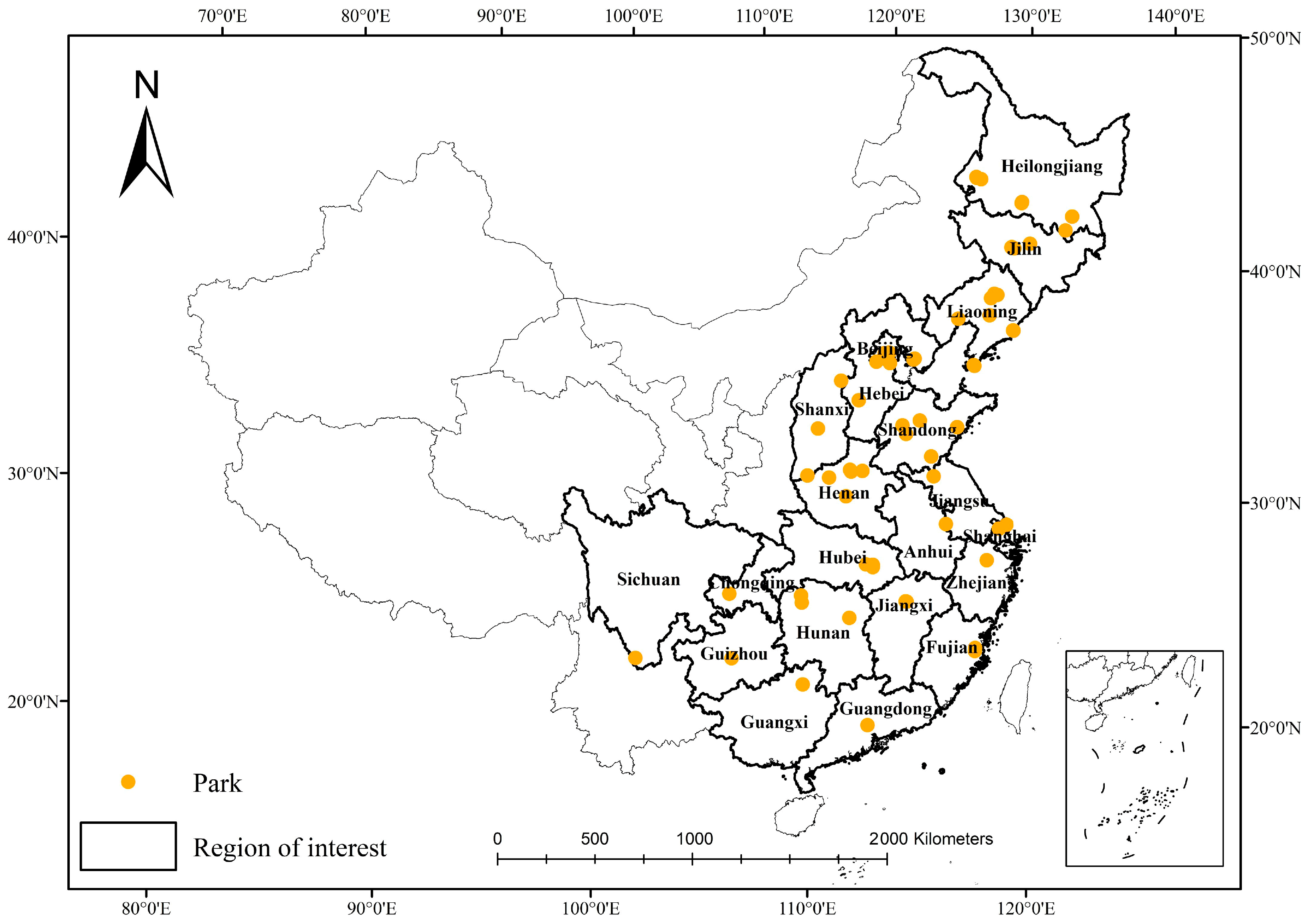
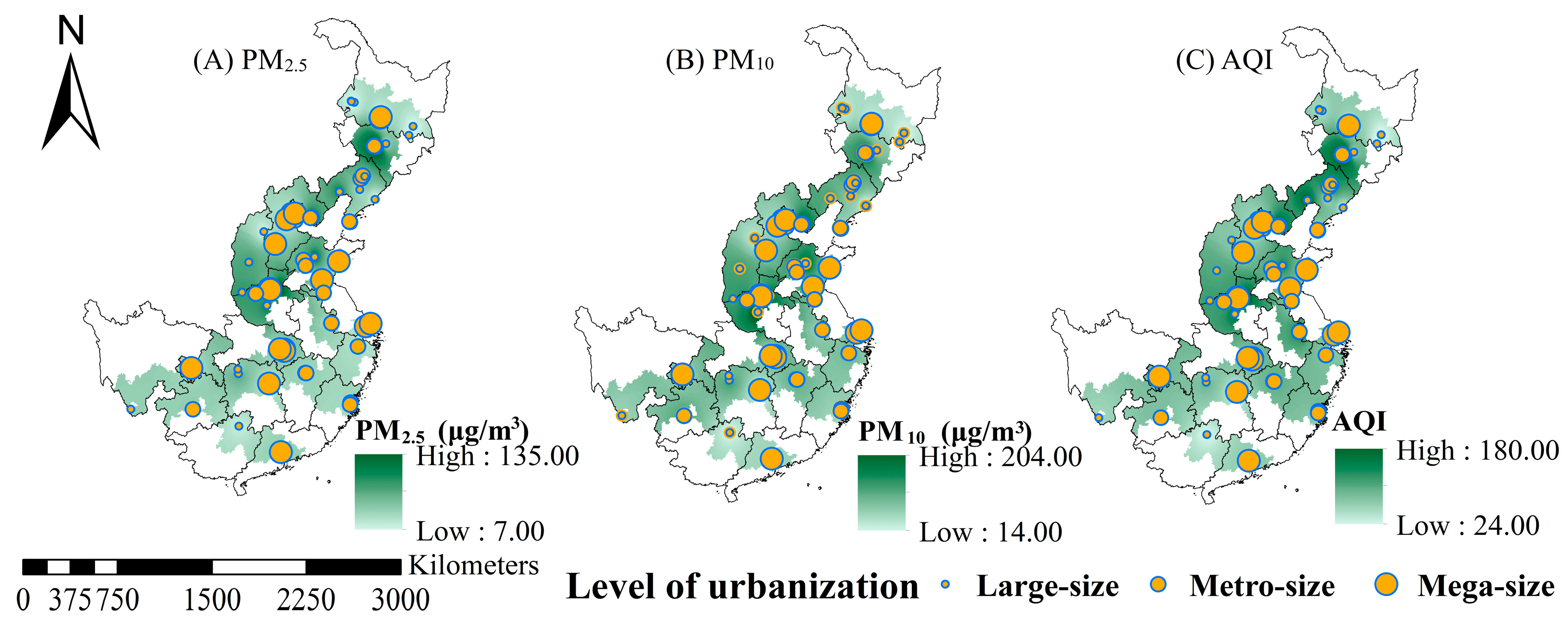
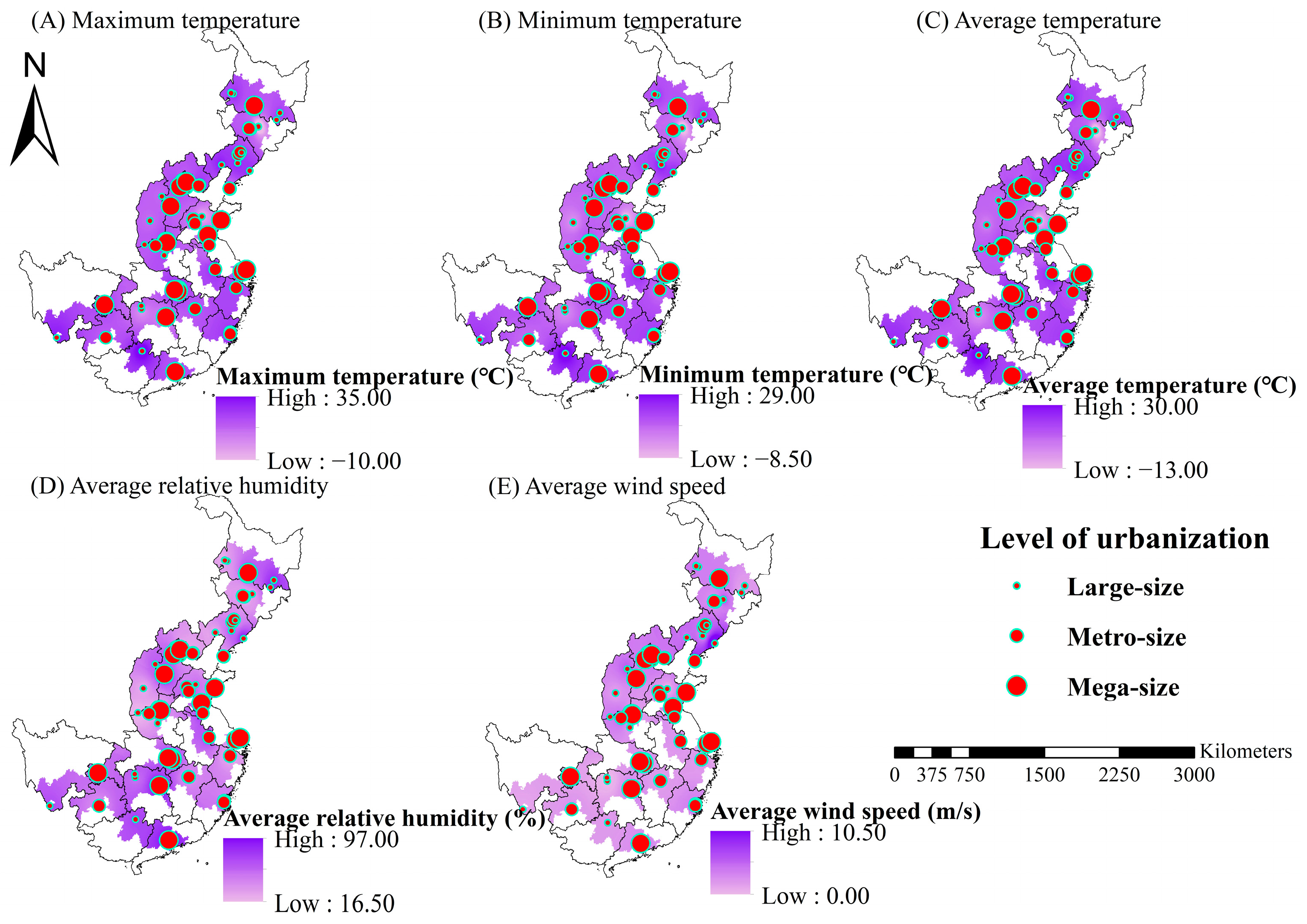
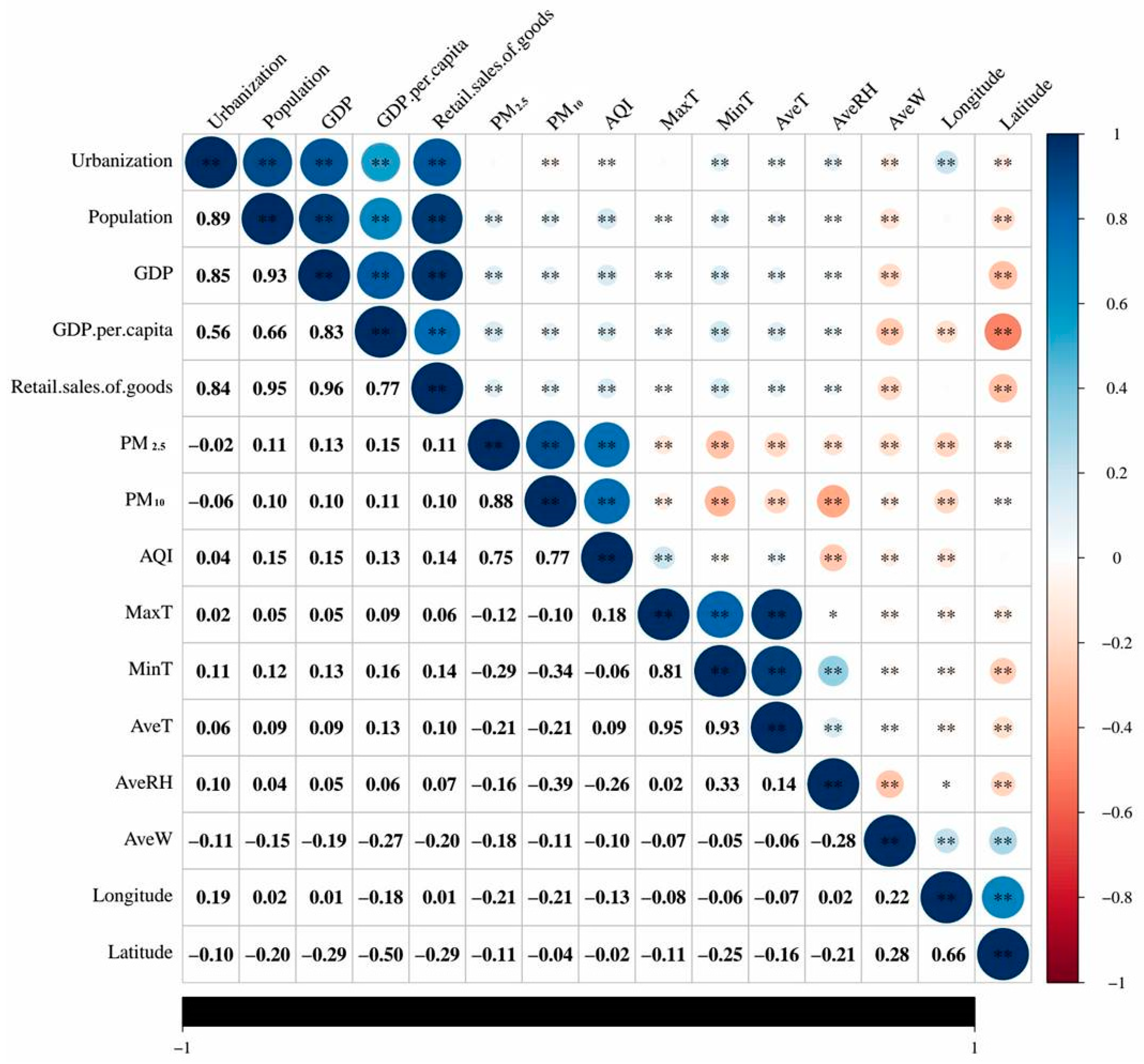
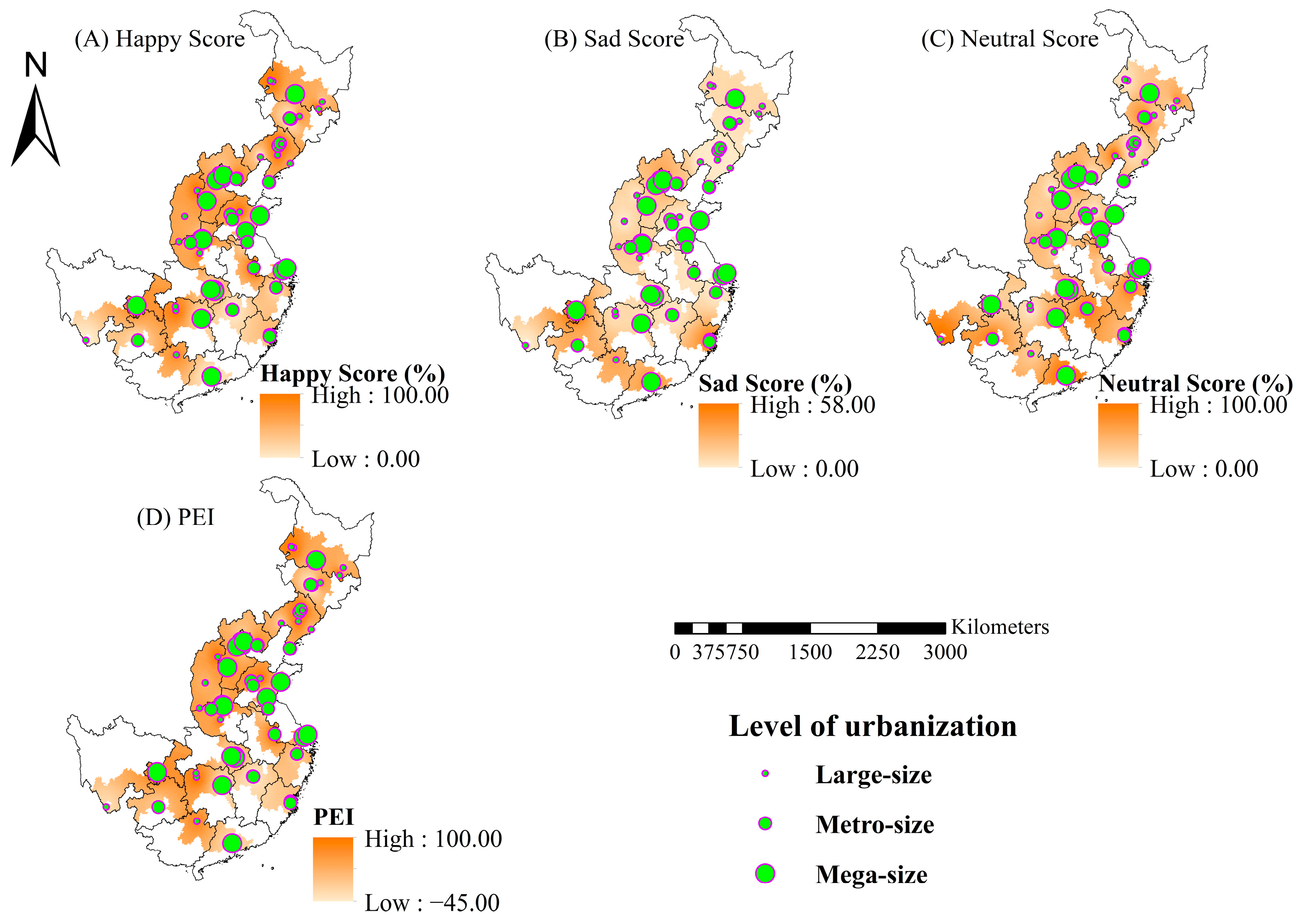
| Independent Variables | Estimate | Std. Error | t Value | Pr(>|t|) | |
|---|---|---|---|---|---|
| Intercept | 4.64 | 0.30 | 15.66 | <2 × 10−16 | *** |
| PM10 | −1.38 × 10−3 | 3.28 × 10−4 | −4.21 | 2.54 × 10−5 | *** |
| Longitude | −9.19 × 10−3 | 3.04 × 10−3 | −3.03 | 2.48 × 10−3 | ** |
| Latitude | 8.51× 10−3 | 2.81 × 10−3 | 3.02 | 2.50 × 10−3 | ** |
| Independent Variables | Estimate | Std. Error | t Value | Pr(>|t|) | |
|---|---|---|---|---|---|
| Intercept | 7.93 | 3.50 × 10−1 | 22.64 | <2 × 10−16 | *** |
| PM2.5 | −2.95 × 10−3 | 1.17 × 10−3 | −2.53 | 1.13 × 10−2 | * |
| PM10 | 1.90 × 10−3 | 7.33 × 10−4 | 2.59 | 9.53 × 10−3 | ** |
| AQI | −1.98 × 10−3 | 7.06 × 10−4 | −2.81 | 4.99 × 10−3 | ** |
| Longitude | −4.12 × 10−2 | 3.84 × 10−3 | −10.73 | <2 × 10−16 | *** |
| Latitude | −2.05 × 10−2 | 3.52 × 10−3 | −5.81 | 6.49 × 10−9 | *** |
| Maximum temperature | 5.16 × 10−2 | 9.35 × 10−3 | 5.51 | 3.66 × 10−8 | *** |
| Minimum temperature | 2.12 × 10−2 | 9.68 × 10−3 | 2.19 | 2.87 × 10−2 | * |
| Average temperature | −6.22 × 10−2 | 1.73 × 10−2 | −3.60 | 3.27 × 10−4 | *** |
| Average relative humidity | −2.23 × 10−3 | 9.57 × 10−4 | −2.33 | 1.98 × 10−2 | * |
| Average wind velocity | −2.29 × 10−2 | 8.02 × 10−3 | −2.85 | 4.35 × 10−3 | ** |
| GDP | 2.26 × 10−4 | 1.46 × 10−5 | 15.50 | <2 × 10−16 | *** |
| GDP per capita | −7.84× 10−6 | 6.15 × 10−7 | −12.76 | <2 × 10−16 | *** |
| Total retail sales of social consumer goods | −4.34 × 10−4 | 3.66 × 10−5 | −11.85 | <2 × 10−16 | *** |
| Independent Variables | Estimate | Std. Error | t Value | Pr(>|t|) | |
|---|---|---|---|---|---|
| Intercept | 3.72 | 2.05 × 10−2 | 181.77 | <2 × 10−16 | *** |
| PM10 | 9.38 × 10−4 | 2.60 × 10−4 | 3.61 | 3.12 × 10−4 | *** |
| Independent Variables | Estimate | Std. Error | t Value | Pr(>|t|) | |
|---|---|---|---|---|---|
| Intercept | 5.23 | 1.26 × 10−1 | 41.49 | <2 × 10−16 | *** |
| PM10 | −5.44 × 10−4 | 1.36 × 10−4 | −4.00 | 6.55 × 10−5 | *** |
| Longitude | −3.82 × 10−3 | 1.29 × 10−3 | −2.97 | 2.97 × 10−3 | ** |
| Latitude | 3.80 × 10−3 | 1.18 × 10−3 | 3.21 | 1.32 × 10−3 | ** |
Disclaimer/Publisher’s Note: The statements, opinions and data contained in all publications are solely those of the individual author(s) and contributor(s) and not of MDPI and/or the editor(s). MDPI and/or the editor(s) disclaim responsibility for any injury to people or property resulting from any ideas, methods, instructions or products referred to in the content. |
© 2023 by the authors. Licensee MDPI, Basel, Switzerland. This article is an open access article distributed under the terms and conditions of the Creative Commons Attribution (CC BY) license (https://creativecommons.org/licenses/by/4.0/).
Share and Cite
Wang, X.; Meng, L.; Liu, Y.; Wei, H. Facial Expressions of Urban Forest Visitors Jointly Exposed to Air Pollution and Regional Climate. Forests 2023, 14, 1571. https://doi.org/10.3390/f14081571
Wang X, Meng L, Liu Y, Wei H. Facial Expressions of Urban Forest Visitors Jointly Exposed to Air Pollution and Regional Climate. Forests. 2023; 14(8):1571. https://doi.org/10.3390/f14081571
Chicago/Turabian StyleWang, Xiaopei, Lingquan Meng, Yifeng Liu, and Hongxu Wei. 2023. "Facial Expressions of Urban Forest Visitors Jointly Exposed to Air Pollution and Regional Climate" Forests 14, no. 8: 1571. https://doi.org/10.3390/f14081571
APA StyleWang, X., Meng, L., Liu, Y., & Wei, H. (2023). Facial Expressions of Urban Forest Visitors Jointly Exposed to Air Pollution and Regional Climate. Forests, 14(8), 1571. https://doi.org/10.3390/f14081571







